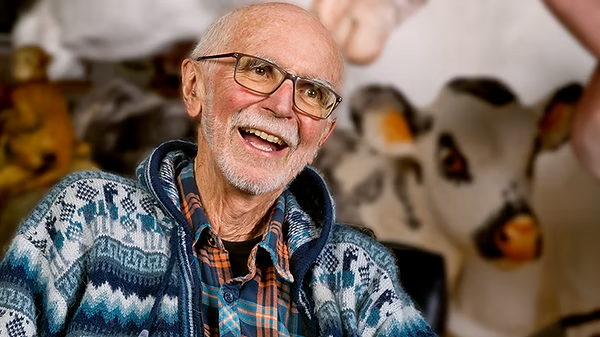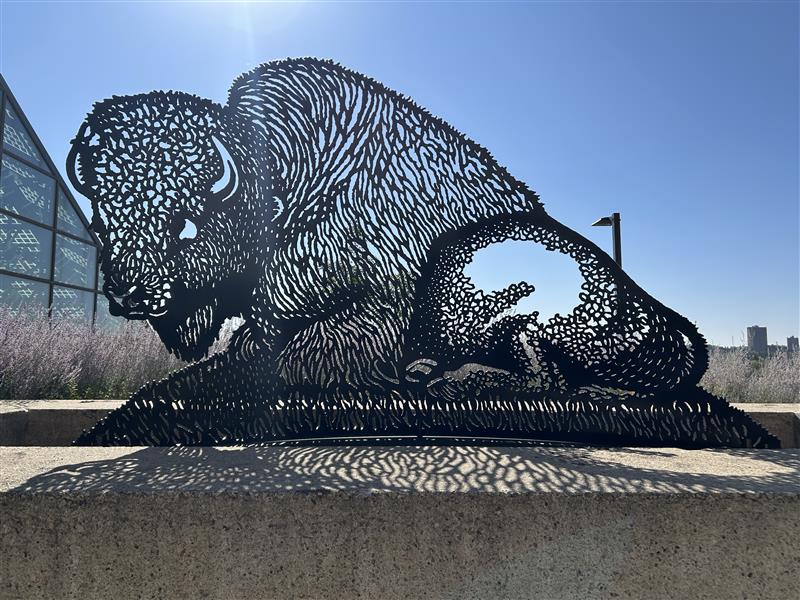To see a bison is to witness the past, present, and spirit of the land converge in a single breath.
As they turned the corner of 97th Street and Jasper Avenue, they stopped short. There it stood. Still, immense, and unmistakably powerful. Larger than expected, its massive pre-historic frame cloaked in dense tufts of brown fur, muscles coiled beneath its thick hide. Their eyes met. Two beings caught in the same breath, uncertain how this encounter had come to be. The bison’s curved horns framed its head like ancient weapons, while its dark, unblinking eyes scanned everything in silence. Even from a distance, they could hear the low pull of its deep breath, the quiet shift of its weight, a presence so commanding it seemed the concrete building around them had drawn still, holding their own breath.
In that instant, it was easy to forget they stood in the heart of Edmonton’s River Valley. Before a towering, 12-foot bison, the traffic, the office towers, the noise all faded. The city slipped into the background, and the land itself seemed to stir, awake and watching.
In that instant, the city fell away. The traffic, the towers, the noise—all faded into silence. Beneath the towering presence of Paskwâmostos, the steel bison, it was as if the spirit of the land stirred, reminding all who walked here whose stories it carried.
The return of a 12-foot stainless steel bison sculpture, called “Paskwâmostos” (Cree for bison), to the Edmonton Convention Centre marked the return of more than just a piece of public art.

Joe Fafard in his studio, December 2018. Photo courtesy of Gary Robins / Available Light Photographics and Design
Created by internationally acclaimed Saskatchewan artist Joe Fafard, “Paskwâmostos” once again overlooks the North Saskatchewan River Valley. The sculpture was originally gifted to the City of Edmonton on February 16, 1990, by JR Shaw, Executive Chairman of Shaw Communications, commemorating the era when the building was known as the Shaw Conference Centre.
After being removed for conservation, it’s return invites the public to reconnect with this iconic art piece. However, the significance of the bison runs deeper than metal and steel.
Observing a Bison is more than just a wildlife sighting, it’s witnessing a powerful symbol of the land we call home.
Observing Bison with Respect, whether in sculpture or on the plains, bison command respect. For those lucky enough to see them in the wild, these are not just photo opportunities, they are encounters with the sacred.
Tips for Bison Watching:
- Keep your distance: At least 100 meters. Bison look slow, but they can run up to 55 km/h.
- Use binoculars or a zoom lens: Don’t approach too closely for a photo.
- Stay quiet: Let them behave naturally, don’t disturb them.
- Be patient: Sometimes the most powerful moments come when you least expect it.
- The Bison Rut: or mating season, happens from late July until early September – be especially cautious during this time.
A Symbol of Canadian Identity
Though the bison is often viewed as a symbol of Canadian identity, representing strength, resilience, and endurance, it holds a deeper, older meaning for Indigenous Nations. It represents reciprocity, responsibility, and the interconnectedness of all life.
Just 45 minutes from the heart of Edmonton, you can see these powerful mammals in motion. Elk Island National Park is one of the world’s leading bison conservation facilities, home to 47,171 acres of land and hundreds of roaming bison.
Once nearly extinct, Elk Island National Park became a sanctuary where bison herds were managed to help rebuild populations across Canada. Elk Island National Park has been transferring bison to Métis Crossing as part of conservation efforts and cultural revitalization initiatives. These transfers, particularly of wood bison, are seen as a significant step in the journey of reconciliation and the restoration of a vital cultural connection. The bison, once hunted to near extinction, are now returning to their traditional lands at Métis Crossing, symbolizing healing and cultural renewal.
Visiting Elk Island National Park offers the chance to take a scenic day trip, reconnect with nature, and if you’re lucky enough, spot a bison in its natural territory.
Many bison preservation efforts are often carried out as a partnership with Indigenous communities, recognizing ancestral ties and supporting reconciliation.
Honouring Indigenous Legacy
For Indigenous Peoples across Turtle Island, the bison is not just a symbol of strength—it is a relative. A sacred being. It provided food, clothing, shelter, tools, and spiritual connection for thousands of years. The bison is woven into language, ceremony, and the teachings passed through generations.
The sculpture’s name “Paskwâmostos”, honors this, speaking to this legacy recognizing the Indigenous roots of the land and the strong enduring spirit of the plains.
We can certainly learn a lesson or two from the bison. The return of “Paskwâmostos” offers a rare chance to appreciate this iconic animal up close without ever leaving the city.
The next time you are near the Edmonton Convention Centre or walking along the Edmonton River Valley, stop for a moment and take in the spirit of this majestic creature. Let the 12-foot silhouette remind you of the history, strength, and the stories that it carries.
Return to News



